Bayer R.G. Mechanical Wear Fundamentals and Testing, Revised and Expanded
Подождите немного. Документ загружается.

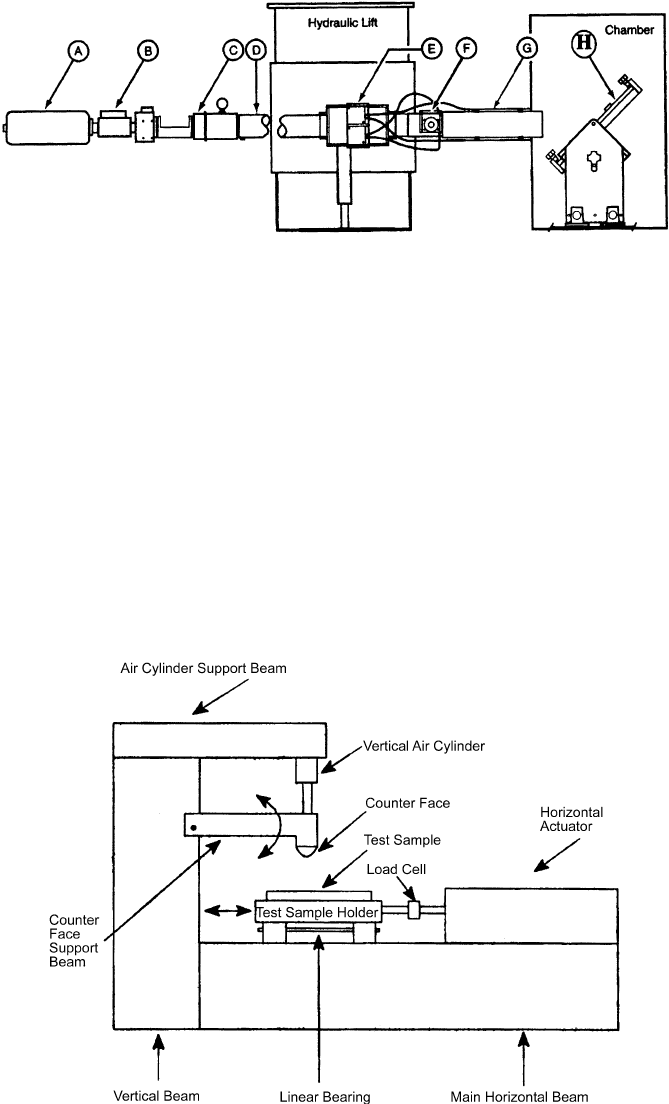
from a single impact. The smaller the area, the greater resistance the paint system has to
this type of wear.
The test for friction-induced damage involves dragging a roun ded slider across a
painted surface, under condition that will cause peeling (70). A schematic of the test appa-
ratusforthistestisshowninFig.9.63
.Figure9.64provides an illustration of the method.
During the test the friction force is monitored and a curve is generated of friction force vs.
slidingdistance,asillustratedinFig.9.65
.Theareaunderneaththiscurveis the energy
expended in the test. The wear resistance of the coated is rated by the ratio of the pealed
area to the energy expended. The smaller this value, the more wear resistance the paint.
Figure9.66
shows a comparison of several coatings as a function of temperature using this
parameter.
Figure 9.62 Diagram of apparatus used to simulate stone impact. ‘‘A’’ air reservoir; ‘‘B’’ fast act-
ing valve; ‘‘C’’ breech (sabot holder); ‘‘D’’ barrel. ‘‘E’’ muzzle valve, ‘‘F’’ velocity measuring system.;
‘‘G’’ insulated muzzle; ‘‘H’’ target mount. (From Ref. 68, reprinted with permission from Elsevier
Sequoia S.A.)
Figure 9.63 Diagram of apparatus used to simulate friction induced damage of paint surfaces.
(From Ref. 70, reprinted with permission from Elsevier Sequoia S.A.)
Copyright 2004 by Marcel Dekker, Inc. All Rights Reserved.
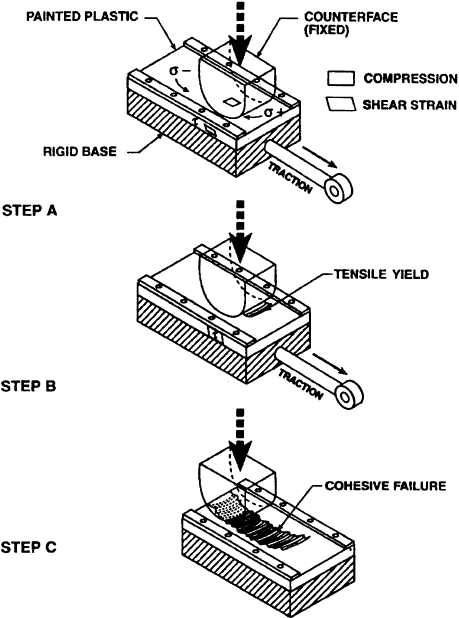
9.2.19. Scratch Test
Scratch tests are primarily used to investigate the effect of various material parameters
with respect to single-cycle deformation processes (71). Typically, these tests involve press-
ing a hard, sharp stylus against a flat specimen of the material to be evaluated and e ither
moving the stylus along the surface or moving the surfa ce underneath the stylus. The
groove is measured and used to characterize the wear resistance. Larger grooves corre-
spond to lower resistance. Styluses with angular and rounded tips are used. In addition
to these sliding scratch tests, pendulum apparatuses are also used. In these, a stylus is
attached to a pendulum, which is dropped with a know amount of energy. The stylus
is set to engage the surface and move across it, creating a groove. The pendulum is then
captured at its peak and before it can swing back across the surface.
Wear behavior in these tests is often additionally characterized in terms of two other
parameters. One is the ratio of the volume of material removed to the volume of material
displaced. This ratio is sometimes called the removal coefficient, degree of wear, or abra-
sive fraction. The second is specific grooving energy, which is the energy dissipated in
Figure 9.64 Phenomenological model for the friction induced damage test. The specimen moves to
the left with the counterface in its stationary position. Step A: normal load is applied and motion
initiated. Step B: onset of damage. Step C: conclusion of test, resulting in friction induced damage.
sþ denotes tension; s denotes compression; t denotes shear. (From Ref. 70, reprinted with
permission from Elsevier Sequoia S.A.)
Copyright 2004 by Marcel Dekker, Inc. All Rights Reserved.
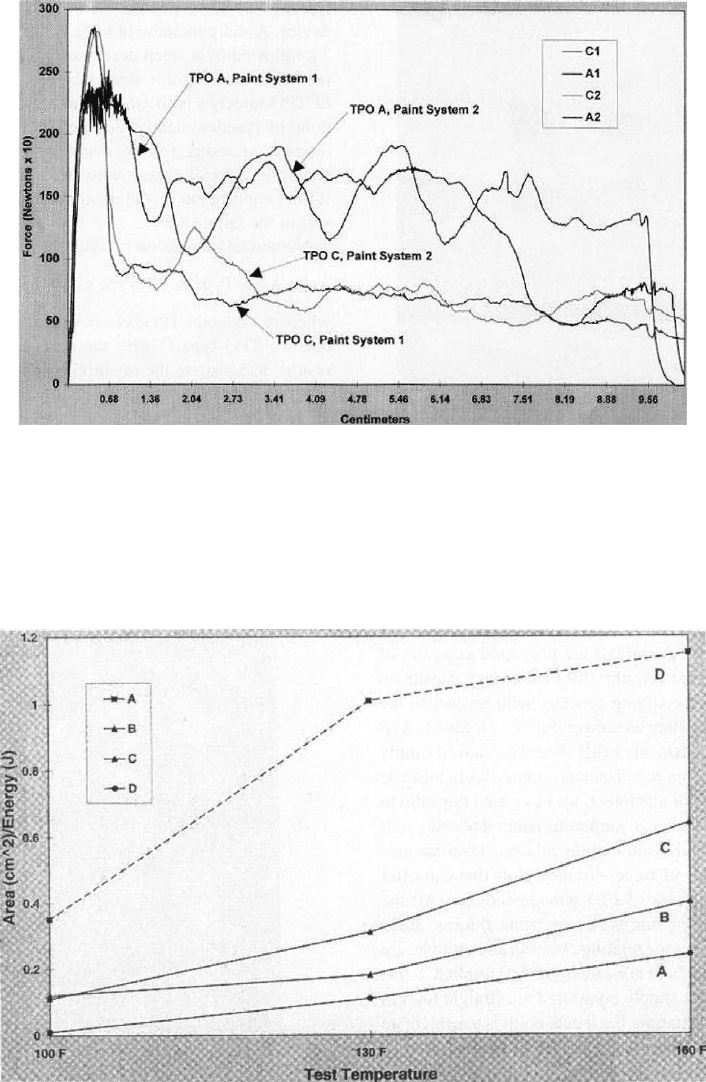
Figure 9.65 Examples of force–distance curves obtained in the test for friction induced damage.
Areas under the curves are the energy lost or dissipated in the test. (From Ref. 70, reprinted with
permission from Elsevier Sequoia S.A.)
Figure 9.66 Example of the comparison of painted surfaces in terms of their resistance to friction
induced damage. Resistance is inversely related to the ratio of the damaged area to the energy dis-
sipated measured in the test. (From Ref. 70, reprinted with permission from Elsevier Sequoia S.A.)
Copyright 2004 by Marcel Dekker, Inc. All Rights Reserved.
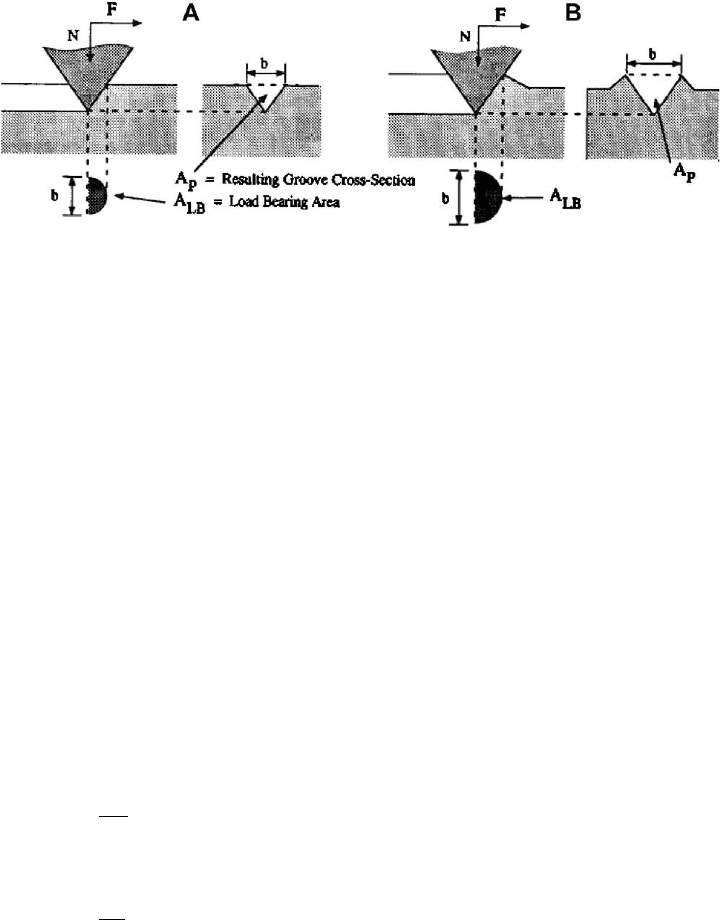
forming per unit of mass removed. For sliding scratch test, this requir es obtaining a force–
displacement curve, such as the one used in the test for friction induced wear of painted
surface (Sec. 9.2.18). With the pendulum type of test, the energy dissipated can be
determined from the difference in the initial and final height of the pendulum.
These types of tests are also used for two other purposes related to wear. One is to
measure adhesive strength of coatings. The other is to obtain a scratch hardness number
for materials (72). For determining adhesive strength of coatings, the load at which
debonding is observed to occur is determined by performing tests at increasing loads. This
load is then directly used to compare materials or converted to a more fundamental mea-
sure of bond strength. In a scratch hardness test, the width of the groove is measured and
used to compute a hardness value. As with an indentation hardness test, hardness in
a scratch test is defined as the ratio of the load to the area supporting the load. This is
illustratedforascratchtestandindentationtestinFig.9.67
. Values vary with the shape
of the stylus. In scratch tests, there are two general shapes typically used for this purpose.
Shapes with circular cross-sections, such as cones, spheres, and parabolas, are one type.
Square-base pyramid shapes are the other type. The equation for scratch hardness using
the former geometries is
H
s
¼
8N
pb
2
ð9:20Þ
For the latter,
H
s
¼
4N
b
2
ð9:21Þ
In these equations, N is the load and b is the width of the groove.
9.2.20. Wear Tests for Coatings
In general, the wear resistance of coatings is evaluated using the same tests that are used
with bulk materials. While this is the case, test parameters are usually different when
these tests are used to evaluate coatings. Generally, test parameters are milder so that
wear in the test can be limited to the coating. Depending on thickness, typical geom-
etrical methods for measuring wear can be used. Mass loss methods are also possible,
Figure 9.67 Illustration of a scratch hardness test using a conical stylus. ‘‘A’’ illustrates the test
when pure cutting is involved; no buildup of ridges. ‘‘B’’ illustrates the test when plowing or defor-
mation also occurs; there is the ridge formation. Note that part of the load, N, is supported by the
ridge. (From Ref. 71, reprinted with permission from ASM International.)
Copyright 2004 by Marcel Dekker, Inc. All Rights Reserved.
if densities are known. For thin coatings, special techniques might be required. An alter-
native to using wear or wear rate as the measure of wear behavior, the life of the coating
in the test is often used to rank and compare coatings. The life can be identified by
examination of the surface for presence of the co ating after tests of different exposure
or duration. Frequently, the life can also be determined by monitoring the friction
during the test. With wear-through, there is often a ch ange in the coefficient friction
that can be detected by such measurements. Additional information on unique aspects
of wear tests with coatings and examples of wear tests for coatings can be found in Refs.
73 and 74.
9.3. OPERATIONAL WEAR TESTS
The examples of phenomenological wear tests discussed in the prior section illustrate some
of the main attributes of that category of wear tests. One is that the phenomenological
tests tend to address major or generic wear situations with the result that actual test con-
figurations are noticeably different than the practical devices or configurations. Another is
that the focus tends to be on the ranking or the determining of appropriate wear coeffi-
cients or parameters of materials and material pairs. As will be seen, operational wear tests
tend to focus on the wear situation associated with individual devices or applications.
While they are also used to rank and select materials, operational tests frequently
allow the effect of other parameters associated with the application to be evaluated. In
addition, with operational wear tests, there may be several potential wear sites and situa-
tions. As a result, the wear mechanisms involved might change as the conditions of the test
change. These aspects, as well as some of the more general aspects of wear testing, will be
illustrated by the consideration of several examples of these types of tests.
9.3.1. Jaw Crusher Gouging Abrasion Test
This test utilizes a jaw crusher to evaluate the wear resistance to what is termed gouging
abrasion. This is a coarse form of abrasion in which macro-gouges and -grooves are pro-
ducedinasingleaction.Figure9.68
shows an example of this type of wear. Fracture of the
abrasives is also a common feature for this type of abrasion. Jaw crushers, which are used
for the crushing of ore an d stone in mining operations, are examples of applications in
which this type of wear occurs. The test is a replica of this type of application and can
be done with a jaw crusher. This is the primary reason for its classification as an opera-
tional test. The test also has a phenomenological aspect as well. For example, rankings
from this type of test have been applied to earth moving equipment, which experience
similar wear but under different conditions (75). Because of the similarity of the wearing
action, this type of apparatus and test has been used successfully to rank coatings for ice-
breaker hulls (76). A standard method (ASTM G81) has been developed for this type of
apparatus when used to crush rock.
ThetestconfigurationisshowninFig.9.69
. Basically, a jaw crusher consists of a
pair of jaws, one stationary and the other articulated. The material to be crushed is fed
between these two jaws and is squeezed by the action of the movable jaw against the sta-
tionary one. In the wear test, two pairs of wear plates are mounted on these jaws; one
member of the pair is a reference material and the other is the material to be tested. They
are mounted in such a manner that the reference and test specimens oppose one another,
asshowninFig.9.70
. The test basically consists of crushing a minimum amount of
rock in a series of steps. At the end of the series, the wear plates are removed and the wear
Copyright 2004 by Marcel Dekker, Inc. All Rights Reserved.
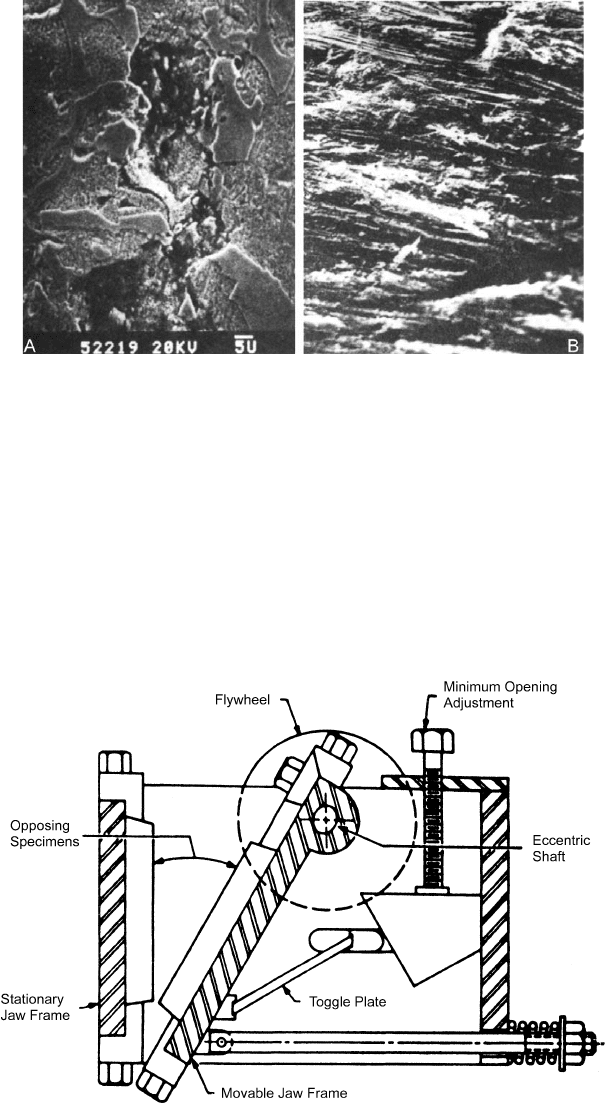
determined by mass loss, which is then converted to volume loss. A wear ratio is estab-
lished for both pairs, dividing the volume of wear of the test specimen by that of the refer-
ence specimen. The two values of this ratio (i.e., the one for the movable and the one for
the stationary jaws) are averaged. It is this average wear ratio that is used to rank materials
against a reference material. A value of less than 1 means improved performance over the
reference material, whereas a value of greater than 1 means poorer performance.
Figure 9.69 Schematic of a jaw crusher apparatus. (From Ref. 125, reprinted with permission
from ASTM.)
Figure 9.68 Example of gouging abrasion. ‘‘A’’ shows the morphology of the worn surface of a
Hadfield steel from a jaw crusher application. ‘‘B’’ shows the morphology of the wear surface of cast
iron bucket teeth. (From Ref. 124, reprinted with permission from ASME.)
Copyright 2004 by Marcel Dekker, Inc. All Rights Reserved.
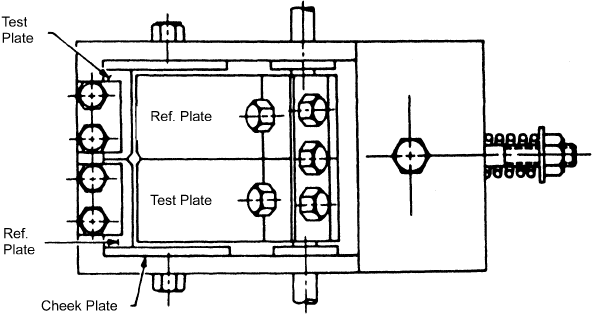
A single apparatus is not specified in the standard method. However, key dimensions
and tolerance are given, as well as guidelines to monitor performance. One key dimension
is the minimum jaw opening, which is specified to be 3.2 mm and the jaws are to be re-
adjusted to this value after crushi ng 225 kg of rock. The minimum amount of rock to
be crushed is 900 kg and twice that amount is recommended for the evaluation of very
wear resistant materials. Because of wear, this dimension is re-adjusted several times dur-
ing the cou rse of a test. As a means of control and calibration, it is also suggested that
three tests be ru n sequentially with all the test plates being reference material. If the aver-
age wear ratios for the last two tests of this sequence vary by more than 3%, the apparatus
should be examined for signs of deterioration and lack of conformance to the specifi-
cations. It is also recommended that a single test of this type be performed after every
six or so normal tests to monitor performance of the apparatus. Finally, it is recommended
that the crushed size of the rock (i.e., after it has gone through the jaw crusher) be moni-
tored. If the size changes, then state of the apparatus and the consistency of the rock used
should be examined and any variations or degradations be addressed.
Specific reference materials or rock to be crushed are not identified or used in the
standard test procedure but the significant attributes of both are identifi ed. For example,
the reference material should have unifor m and consistent properties. The size of the rock
to be crushed is a key factor and is specified. It must be precrushed to a particle size 25–
50 mm and it should be hard and tough. A morainal rock of a specific composition is given
as an example of an appropriate material to be used in the test. The test method requires
that the rock and reference material used should be reported, along with an adequate
description of their properties, when report ing the rankings obtained with this test.
However, while absolute amounts of wear vary with the type of rock crushed, it has been
found that similar rankings are obtained with different types of rock. This is a conse-
quence of using an index based on relative performance to a reference material, which
tends to reduce the effect of different rock properties on results.
The standard test method also addresses technique, specimen preparation and
cleaning procedures. Because of the gross nature of this wear process, there is less con-
cern wi th cleaning, surface preparation, and surface control than with many other wear
tests. Cleaning is part of the test method mainly to insure accurate mass change data.
Figure 9.70 Position of reference and test specimens in the ASTM jaw crusher test. (From Ref.
125, reprinted with permission from ASTM.)
Copyright 2004 by Marcel Dekker, Inc. All Rights Reserved.
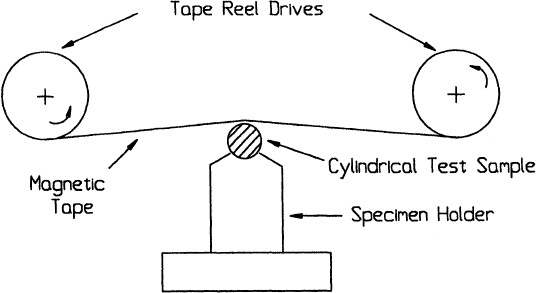
For the same reason, surface preparation is required to insure that initial rust or slag
layers are removed.
When the test is used as an operational test for a jaw crusher, the rankings can be
used directly in establishing absolute performance. This requires knowing the life of the
reference material in that application. The lives of other materials in that application
can be determined by multiplying the life of the reference material by the reciprocal of
the index. This illustrates an advantage that many operational tests can provide (i.e., direct
scaling of field performance).
However, the test does not directly provide a means of determining absolute wear
performance in an y application involving gouging abrasion. It simply provides a rank-
ing for gouging abrasion resistance with respect to an arbitrary refer ence material,
based on an operational type of test (e.g., crushing of a particular amount of rock).
It does not provide the value of a wear coefficient that can provide a relationship
between wear and parameters as load, type of rock crushed, or the amount of rock
crushed. Such a type of relationship is needed to provide a means of quantitatively
relating the test result to an application. Values of these test parameters can be factors
affecting the absolute difference in the relative performance of materials found in the
test and in the application. Consequently, the correlation of the test rankings to relative
performance in an application other needs to be addressed on a case-by-case basis. An
alternate way of stating this is that the sensitivity of the test with respect to an applica-
tion needs to be established on a case-by-case basis. For example, large test differences
might correspond to negligible differences in an application. Alternatively with some
applications, a small difference in test results might correspond to a very large differ-
ence in the application. However, reproducibility of this type of test is good. When
this test is performed in the manner described in ASTM G81, variation should be
within 5%.
9.3.2. Cylindrical Abrasivity Test
This test is one of several that have been used to determine the abrasivity of magnetic
tapes.AnacronymforthisparticulartestisSCAT
, which stands for SpinPhysics Cylind-
rical Abrasivity Test (77,78). This test is quite similar in concept to a rod wear test devel-
opedinthe1960s(79).ThebasicconfigurationofthetestisshowninFig.9.71
. The test
Figure 9.71 The basic configuration of the rod wear test and the SCAT wear tests.
Copyright 2004 by Marcel Dekker, Inc. All Rights Reserved.
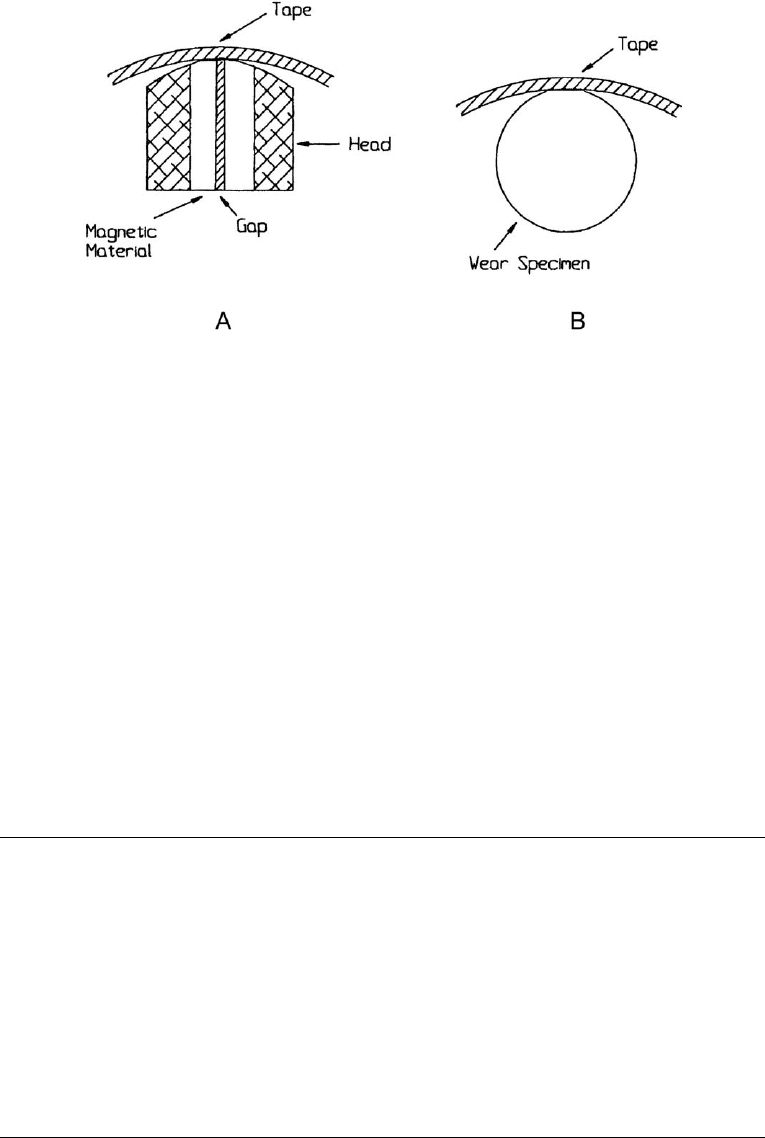
utilizes a commercially available tape drive, replacing the normal magnetic head with a
cylindrical wear specimen. The similarity of the contact between the tape and a recording
headandthetapeandacylindricalspecimenwithsomewearisshowninFig.9.72
. The
basic test consists of running the tape across the surface of the cylinder for 10 hr and mea-
suring the depth of wear produced during that period. The depth rate of wear is used as a
measure of the abrasivity of the tape. This rate is used as a figure of merit for tape abra-
sivity, rather than as an absolute measure. This is because it is determined for only
one representative condition and the methodology of the test does not address the effects
that differences in various operational parameters, such as tension, speed, etc., can have
on actual wear performance.
AsummaryoftheparametersusedinthetestisgiveninTable9.4
. The load
between the tape and the cylinder is determined by the tension in the tape and wrap
Figure 9.72 ‘‘A’’ illustrates the contact configuration between the head and the tape in a typical
application. ‘‘B’’ shows the contact configuration between a worn cylinder and the tape in the SCAT
and rod tests.
Table 9.4 Parameters in the SCAT Test
Wear bar Material Spinalloy
Dimensions
Shape Cylinder 1.5 in. long, 0.250 in. diameter
Finish 1 min average
Support Accuracy Azimuth and tilts 1 min of arc
Test transport Drive Honeywell Model 7600
Tape
Wrap 5
each side of test bar
Tension 8 oz.=in. of tape width
Speed 60 in.=sec
Width 0.5 or 1 in.
Environment Moisture Relative humidity to be controlled within 2% of the desired value
Duration Test time 10 hr
Source: Ref. 77.
Copyright 2004 by Marcel Dekker, Inc. All Rights Reserved.

angle of the tape around the cylinder. The size, roughness, and composition of the
cylindrical wear specimen were selected to be representative of magnetic heads. The test
allows the use of standard reels of either 1=2
00
-or1
00
-wide tapes. All the mechanical and
material parameters have to be controlled for reproducibility. In addition, since moist-
ure can have an effect on the wear between heads and tapes, a tolerance is placed on
the relative humidity under which the test is conducted. The actual temperature and
humidity of the test should be given with the figure of merit that is determined in
the test.
The test utilizes a novel way of measuring wear depth, involving a form of break-in.
The basic cylinder of Spinallo y, a head material made by SpinPhysics, is installed in the
apparatus. With a sample of the tape, a small flat spot or window is developed on the
cylinder. This window is the wear region for the test. The cylinder is then removed and
a series of micro-hardness ind entations are placed in this window, using a diamond pyra-
mid indenter. The cylinder is then coated with a sputtered coating of ceramic to fill the
indentations. This helps maintain the edges of the indentations during wear and enables
small amou nts of wear to be determined. The cylinder is remounted in the apparatus
and a sample of the tape to be tested is used to remove the ceramic coating in the window
area. The cylinder is removed and the diagonal of the diamond indentations is measured
and recorded as the initial values. The cylinder is then replaced, an unused tape sample is
mounted, and the test performed. The cylinder is removed at the end of the test and the
diagonals of the indentations are measured again. The depth of wear, d, is determ ined
by the following equation:
d ¼ 0:1428 ðD
i
D
f
Þð9:22Þ
where D
i
and D
f
are the initial and final diagonal measurements. Eq. (9.22) is based on the
geometry of the diamond micro-hardness indenter used. This technique is illustrated in
Fig.9.73
.
The SCAT test provides an opportunity to compare directly an operational
test and a phenomenological test used for the same purpose. A phenomenological
test has also been used to rank magnetic tapes in terms of their abrasivity (79). The
testutilizesaball–planecontactsituation(Fig.9.74
). A sphere is used to press the moving
magnetic tape against a flat wear specimen. This produces a spherical-shaped wear scar
in the flat wear specimen. The volume of this wear scar can be determined from pro-
filometer measurements and the use of geometrical relationships, as has been described
with other test methods (see Secs. 9.2.6, 9.2.8, 9.2.11, and 9.2.12). The test provides a
Figure 9.73 The use of microhardness indentations in determining wear depth in the SCAT test.
Copyright 2004 by Marcel Dekker, Inc. All Rights Reserved.
